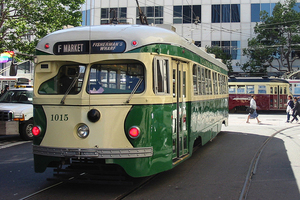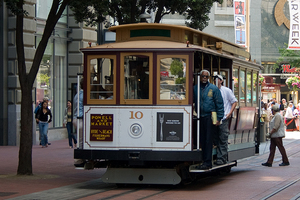To a transit enthusiast, this may seem like a silly question, but what exactly are the basic differences between streetcars (also called trolleys or trams) and cable cars?
Cable cars
Cable cars run on steel rails with a slot between the tracks where an underground cable runs at a continuous nine miles per hour.
The cable runs from a central powerhouse, from huge winding wheels, as the cable cars themselves are completely mechanical and have no means of independent locomotion (no motors).
In order to move forward, the underground cable is grabbed by a grip on the cable car that works like a pair of pliers.
Originally, the powerhouse used steam power to run the cables beneath the streets, but as electricity became more commonplace, steam engines gave way to electric motors (hydroelectric power) which wind the huge wheels that spin the cable to this very day.
Cable cars were invented in 1873 by Andrew Hallidie to climb the hills of San Francisco. Many cities once had cable cars, but today, San Francisco’s Powell-Mason, Powell-Hyde, and California Street lines are the only ones left in the world. The Powell Street cable lines and the F-line form an ‘iron triangle’ of historic transit service between Downtown San Francisco and Fisherman’s Wharf.
Cable cars are often misidentified as ‘trolleys’, but that term refers specifically to the trolley pole used by streetcars to get power from an overhead wire (hence streetcars are often called trolleys, correctly). Cable cars use no overhead wire, and have no trolley poles. Cable cars can be most easily identified by their open end sections with running boards where riders can stand outside of the car, as seen in the picture above.
And don’t be fooled by the number of replica cable cars that can be seen driving around the city on rubber tires (even though some of them were converted from retired authentic cable cars). The real San Francisco cable cars run only on steel rails, and only on the California Street, Powell-Mason, and Powell-Hyde lines.
Streetcars (trolleys/trams)
Streetcars also run on steel rails, but with no slot between the tracks, and no underground cable. Unlike the mechanical cable cars, streetcars are propelled by onboard electric motors and require a trolley pole to draw power from an overhead wire.
 Rick Laubscher photo.
Rick Laubscher photo.Far faster than any earlier form of urban transportation, the streetcar quickly eclipsed cable cars and horsecars as America’s choice for transit in the first half of the 20th century. With 100,000 vehicles and 45,000 miles of track in the US by 1918, the streetcar helped trigger rapid urban growth and created the nation’s first true suburbs.
San Francisco has the world’s most diverse collection of streetcars in regular transit service, and many are quite unique and different looking. This makes streetcars more difficult to classify by sight than the cable cars, which are all very similar in appearance. But, there’s a simple test to distinguish streetcars from cable cars:
If it runs on steel rails with a trolley pole connected to an overhead wire above, it’s a streetcar.
If it runs on steel rails with an open slot between them, and no overhead wires, it’s a cable car.
(And just to confuse things further, San Francisco is also one of the few American cities that operates trolley coaches, which look like regular buses, but are completely electric and have twin poles on the roof of the bus that draw power from double overhead wires. So, if it connects to a pair of overhead wires but has rubber tires like a bus, it’s a trolley coach. Market Street Railway has helped Muni preserve four historic trolley coaches dating from the 1940s and 1950s, though they are not currently used in service.)
